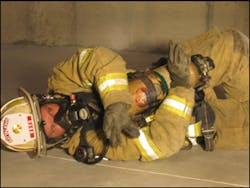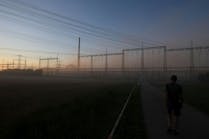Many case studies have documented firefighters becoming trapped or entangled in wires or cables when ceilings collapse.S.C.B.A. Entanglement Hazards
This is the fourth part in a series of articles focused on considerations for proper and safe S.C.B.A. use. It is important to stress that the procedures introduced are to be utilized only under extreme circumstances. The procedures are meant to be utilized as last resorts in saving your own life or that of another firefighter.
With the increasing technological advances in communication systems and networking in today's world also comes an increased hazard to firefighters. Numerous cables and wires are run through drop ceilings to facilitate these various systems. Also now prevalent is appliance and ventilation ductwork made from wire that is covered with a plastic or aluminum type "skin". Once subjected to heat, the plastic melts and the wound wire becomes very difficult to see. These hazards are not only present in office and commercial occupancies but also in residential structures as well.
Many case studies have documented firefighters becoming trapped or entangled in these types of wires or cables when these ceilings collapse. The entanglement often occurs in the area of the firefighter's S.C.B.A. A V-type or lean-to collapse will often occur when a drop ceiling collapses. For this reason, most wires and cables will be located away from the walls towards the center of the room. If possible, it is recommended that a firefighter position themselves face up with their S.C.B.A. against a wall to navigate through an entanglement obstacle. This allows their body to protect their S.C.B.A. from entanglement, enables them to use their hands and allows them to see the obstacle as they go through it.
If a firefighter becomes entangled, it is imperative that they stop forward movement as trying to forcefully move forward will only pull an entanglement tighter on their S.C.B.A. and possibly wedge it into a position that they can not possibly reach. It is strongly recommended that firefighters carry wire cutters to free themselves from an entanglement. These cutters should be large enough to be operated with a gloved hand and be capable of cutting heavy gauge wire that may be encountered.
When cutting wires that a firefighter is entangled by, it is important that only one wire at a time be cut to avoid possible injury in the case that utilities have not been fully controlled. For this same reason a firefighter should brush wires out of their path with an open hand or the back of their hand.
In addition to the traditional "swim" technique for navigating entanglement hazards, another technique found to be very useful is the "Football" Carry. (Referred to as such because it mimics a fullback protecting a football from having a fumble forced.)
Performing the "Football" Carry technique for entanglement:
- Identify entanglement hazard.
- Stop forward motion. Sometimes just stopping forward motion and backing up slightly may disengage an entanglement if encountered.
- The firefighter loosens up the shoulder straps of the S.C.B.A., removes the pack and places their arms back into the shoulder straps that were opposite. The S.C.B.A. will be on in front of their torso like a papoose. (see photo 1)
- The firefighter lies on their left side tucking the S.C.B.A. into their body as much as possible and proceeds through the entanglement with their arms crossed over protecting the S.C.B.A. If needed, one arm can be used to "swim" hazards up and out of the way. (see photo 2)
An advantage of the "football" carry technique is that it allows a firefighter the ability to protect the areas that were vulnerable to getting tangled. It also gives the firefighter the ability to reach the high probability entanglement areas that were quite difficult to reach with the S.C.B.A. on the back.
The S.C.B.A. is only exceeded by the brain as the most important tool for a firefighter. Operating with this piece of equipment in less than ideal conditions should become second nature with all firefighters. Practice and training may save a firefighter's life if ever confronted by the ultimate test.
(More information on Emergency S.C.B.A. Techniques can be obtained from the text R.I.C.O., Rapid Intervention Company Operations available through Thomson Delmar Learning.)
Related:
- S.C.B.A. Considerations: Air Management Is Critical on Fireground
- Air Consumption for Fire Ground Survival
- S.C.B.A. Restrictive Area Techniques
Jeffrey Pindelski is a 16 year plus student of the fire service and currently a Battalion Chief with the Downers Grove Fire Department in Illinois. He previously served for 12 years as a Firefighter and Lieutenant on the Truck and Heavy Rescue Company. Jeff is a staff instructor at the College of Du Page and also instructs courses at the Downers Grove Fire Academy. He has been involved with the design of several training programs dedicated to firefighter safety and survival and is the coauthor of the text R.I.C.O., Rapid Intervention Company Operations.






